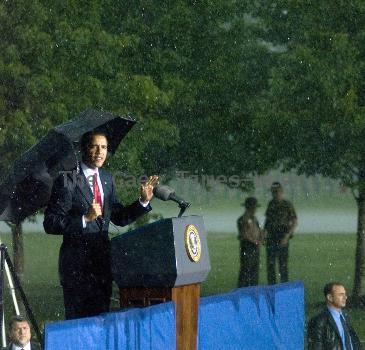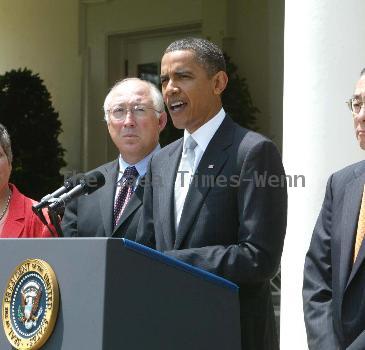Well cap captures more oil, but the spill is breaking up into patches, and outlook is gloomy
By Ray Henry, APMonday, June 7, 2010
Well cap captures more oil, but outlook’s gloomy
NEW ORLEANS — The cap on the blown-out well in the Gulf is capturing a half-million gallons a day, or anywhere from one-third to three-quarters of the oil spewing from the bottom of the sea, officials said Monday. But the hopeful report was offset by a warning that the farflung slick has broken up into hundreds and even thousands of patches of oil that may inflict damage that could persist for years.
Coast Guard Adm. Thad Allen, the government’s point man for the crisis, said the breakup has complicated the cleanup.
“Dealing with the oil spill on the surface is going to go on for a couple of months,” he said at a briefing in Washington. But “long-term issues of restoring the environment and the habitats and stuff will be years.”
Allen said the containment cap that was installed late last week is now collecting about 460,000 gallons of oil a day out of the approximately 600,000 to 1.2 million gallons believed to be spewing from the well a mile underwater. In a tweet, BP said it collected 316,722 gallons from midnight to noon Monday.
The amount of oil captured is being slowly ramped up as more vents on the cap are closed. Crews are moving carefully to avoid a dangerous pressure buildup and to prevent the formation of the icy crystals that thwarted a previous effort to contain the leak. The captured oil is being pumped to a ship on the surface.
“I think it’s going fairly well,” Allen said.
BP said it plans to replace the cap — perhaps later this month or early next month — with a slightly bigger one that will provide a tighter fit and thus collect more oil. It will also be designed to allow the company to suspend the cleanup and then resume it quickly if a hurricane threatens the Gulf later this season. The new cap is still being designed.
“It gives us much better containment than we’ve got” with the existing cap, said BP senior vice president Kent Wells.
BP and government officials acknowledged it is difficult to say exactly how much oil is spewing from the well, and thus how much is still flowing into the water. BP spokesman Robert Wine said the figures being discussed are estimates, some of which have been provided by the government.
Ed Overton, a Louisiana State University professor of environmental sciences, suggested it is too early for anyone to claim victory. The spill, estimated at anywhere from 23 million gallons to 50 million, is already the biggest in U.S. history, dwarfing the 1989 Exxon Valdez disaster in Alaska.
“We’re hopeful the thing is going to work, but hoping and actually working are two different things,” Overton said. “They may have turned the corner, they may not have. We just don’t know right now.”
He said he doesn’t believe BP will have turned the corner until it sees a significant flow from the well stopped. “And it is not entirely obvious to me that that is happening,” Overton said.
“I do worry we are not removing as much oil as we ought to be getting,” he added.
The “spillcam” video of the leak continued to show a big brown billowing cloud of oil and gas 5,000 feet below the surface.
In Washington, President Barack Obama sought to reassure Americans that “we will get through this crisis.”
Later, he said he’s been talking closely with Gulf Coast fishermen and various experts on BP’s catastrophic oil spill and not for lofty academic reasons.
“I talk to these folks because they potentially have the best answers — so I know whose ass to kick,” the president said.
The salty words, part of Obama’s recent efforts to telegraph to Americans his engagement with the crisis, came in an interview in Michigan with NBC’s “Today” show.
“This will be contained,” he said earlier. “It may take some time, and it’s going to take a whole lot of effort. There is going to be damage done to the Gulf Coast, and there is going to be economic damages that we’ve got to make sure BP is responsible for and compensates people for.”
But in a forecast that was by turns hopeful and gloomy, Allen indicated that cleaning up the mess could prove to be more complex than previously thought.
“Because what’s happened over the last several weeks, this spill has disaggregated itself,” Allen said. “We’re no longer dealing with a large, monolithic spill. We’re dealing with an aggregation of hundreds or thousands of patches of oil that are going a lot of different directions.”
When finished, the new cap would be connected a riser pipe floating about 300 feet below the surface. Engineers say the riser would be deep enough to avoid damage from hurricanes that can roar over the Gulf of the Mexico, but shallow enough to allow returning drill ships to quickly reconnect to the flow.
Meanwhile, crews worked furiously to skim, scour and chemically disperse the substance from the water.
Tony Wood, the director of the National Spill Control School at Texas A&M University in Corpus Christi, said BP’s success at containing some of the leaking oil would not dramatically reduce the amount of time it would take to clean up the Gulf.
“We have a large volume still escaping,” he said. “Cleanup levels up to twice as large as we have right now will go on for at least a year.” He added: “The reality is that most of the spill, the vast majority of the spill, is still well offshore.”
The oil — brick red in places, chocolate brown in others — has washed up on the shores of Louisiana, Mississippi, Alabama and the Florida Panhandle.
Some of the most enduring images of the disaster are of pelicans and other wildlife drenched in oil.
In a sweltering metal building in Fort Jackson, workers in biohazard suits were doing the time-consuming task of cleaning oiled brown pelicans and releasing them back into the wild. After getting 192 in the last six weeks, 86 were delivered on Sunday, the biggest rescue since the BP rig exploded on April 20, spewing oil into the Gulf of Mexico.
“We did have someone faint today because of the heat,” said Jay Holcomb, executive director of the International Bird Rescue Research Center. “But usually they come in about six or seven in the morning and stay until about six or seven at night.”
A table is lined with tubs, bottles and even a microwave. In the tub an enormous pelican, turned almost black by the oil, sits stoically as workers pour a light vegetable oil over it. A process they humorously refer to as marinating, which has to be done before the birds can be washed.
Other than the oil, the pelicans have been healthy, said Heather Nevill, the veterinarian overseeing the process.
“They respond really well to the cleaning,” Nevill said. “If we get them in time.”
At Barataria Bay, La., just west of the mouth of the Mississippi River, large patches of oil the consistency of pancake batter floated in the still waters. A dead sea turtle caked in brownish-red oil lay splayed out with dragonflies buzzing by.
The Barataria estuary, which has become one of the hardest-hit areas, was busy with shrimp boats skimming up oil and officials in boats and helicopters patrolling the islands and bays to assess the state of wildlife and the movement of oil. On remote islands, pelicans, gulls, terns and herons were stained with oil.
Jody Haas, a tourist from Aurora, Ill., was among the few walking on tar-stained Pensacola Beach. Haas, who has visited the beach before, said it wasn’t the same.
“It was pristine, gorgeous, white sand,” she said. “This spot is light compared to some of the other spots farther down and it is just everywhere here. It’s just devastating, awful.”
Harry Weber reported from Houston. Associated Press writers contributing to this story were Tamara Lush in New Orleans, Cain Burdeau in Barataria Bay, La., Mary Foster in Fort Jackson, La., Melissa Nelson in Pensacola, Fla., Mitch Stacy in St. Pete Beach, Fla., Jay Reeves in Orange Beach, Ala., and Tom Raum in Washington.
Tags: Accidents, Animals, Barack Obama, Birds, Coastlines And Beaches, Environmental Concerns, Environmental Conservation And Preservation, Florida, Louisiana, New Orleans, North America, Oil spill, Pensacola, United States, Wildlife

















